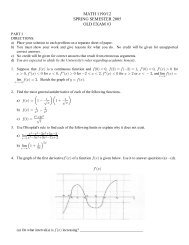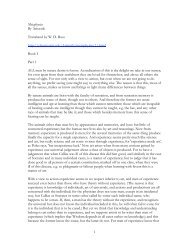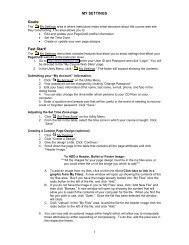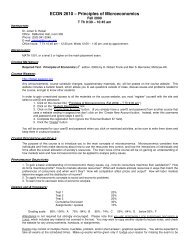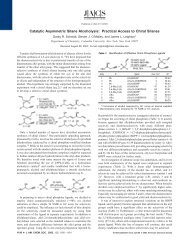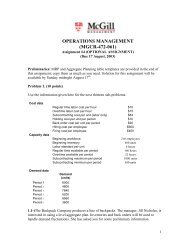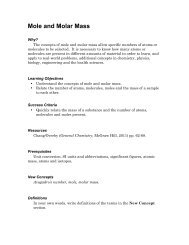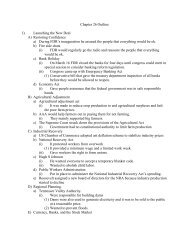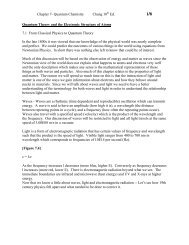Create successful ePaper yourself
Turn your PDF publications into a flip-book with our unique Google optimized e-Paper software.
<strong>Capital</strong> <strong>Budgeting</strong>Estrategias de DirecciónFinanciera© Dr. Daniel Ayala
The <strong>Capital</strong> <strong>Budgeting</strong> Decision ProcessThe capital budgeting process involves three basicsteps:• Generating long-term investment proposals;• Reviewing, analyzing, and selecting from theproposals that have been granted, and• Implementing and monitoring the proposalsthat have been selected.Managers should separate investment andfinancing decisions.
<strong>Capital</strong> <strong>Budgeting</strong> Decision TechniquesAccounting rate of return (ARR): focuses onproject’s impact on accounting profitsPayback period: most commonly usedNet present value (NPV): best techniquetheoretically; difficult to calculate realisticallyInternal rate of return (IRR): widely used withstrong intuitive appealProfitability index (PI): related to NPV
A <strong>Capital</strong> <strong>Budgeting</strong> Process Should:Account for the time value of money;Account for risk;Focus on cash flow;Rank competing projects appropriately, andLead to investment decisions that maximizeshareholders’ wealth.
Example: Global Wireless• Global Wireless is a worldwide provider ofwireless telephony devices.• Global Wireless is contemplating a majorexpansion of its wireless network in twodifferent regions:– Western Europe expansion– A smaller investment in Southeast U.S. to establish atoehold
Global WirelessInitial Outlay -$250Year 1 inflow $35Year 2 inflow $80Year 3 inflow $130Year 4 inflow $160Year 5 inflow $175Initial Outlay -$50Year 1 inflow $18Year 2 inflow $22Year 3 inflow $25Year 4 inflow $30Year 5 inflow $32
Accounting Rate Of Return (ARR)Can be computed from available accounting dataARR =Average profitsafter taxesAverage profits after taxesAverage investment• Need only profits after taxes and depreciation.• Average profits after taxes are estimated bysubtracting average annual depreciation from theaverage annual operating cash inflows.= Average annual –operating cash inflowsAverage annualdepreciationARR uses accounting numbers, not cash flows;no time value of money.
Payback PeriodThe payback period is the amount of time requiredfor the firm to recover its initial investment.• If the project’s payback period is less than themaximum acceptable payback period, acceptthe project.• If the project’s payback period is greater thanthe maximum acceptable payback period,reject the project.Management determines maximum acceptablepayback period.
Payback Analysis For Global Wireless• Management’s cutoff is 2.75 years.• Western Europe project: initial outflow of -$250M– But cash inflows over first 3 years is only $245 million.– Global Wireless will reject the project (3>2.75).• Southeast U.S. project: initial outflow of -$50M– Cash inflows over first 2 years cumulate to $40 million.– Project recovers initial outflow after 2.40 years.• Total inflow in year 3 is $25 million. So, the projectgenerates $10 million in year 3 in 0.40 years ($10 million ÷$25 million).– Global Wireless will accept the project (2.4
Pros and Cons of the Payback MethodAdvantages of payback method:• Computational simplicity• Easy to understand• Focus on cash flowDisadvantages of payback method:• Does not account properly for time value of money• Does not account properly for risk• Cutoff period is arbitrary• Does not lead to value-maximizing decisions
Discounted Payback• Discounted payback accounts for time value.• Apply discount rate to cash flows during payback period.• Still ignores cash flows after payback period.• Global Wireless uses an 18% discount rate.Reject (166.2 < 250)Reject (46.3
Net Present Value (NPV)NPV: The sum of the present values of a project’scash inflows and outflows.Discounting cash flows accounts for the time valueof money.Choosing the appropriate discount rate accounts forrisk.NPV=CF0+CF1CF2CF3CFN+ + + ... +23( 1+r)( 1+r)( 1+r)( 1+r)NAccept projects if NPV > 0.
Net Present Value (NPV)NPV=CF0+CF1CF2CF3CF+ + + ... +23( 1+r)( 1+r)( 1+r)( 1+r)NNA key input in NPV analysis is the discount rate.r represents the minimum return that theproject must earn to satisfy investors.r varies with the risk of the firm and /or the riskof the project.
NPV Analysis for Global Wireless• Assuming Global Wireless uses 18% discount rate,NPVs are:Western Europe project: NPV = $75.3 millionNPVWesternEurope35 80 130 160= $ 75.3 = −250+ + + + +234(1.18) (1.18) (1.18) (1.18)175(1.18)5Southeast U.S. project: NPV = $25.7 millionNPVSoutheastU . S.18 22 25 30= $ 25.7 = −50+ + + + +234(1.18) (1.18) (1.18) (1.18)32(1.18)5Should Global Wireless invest in one project or both?
The NPV Rule and Shareholder Wealth
Pros and Cons of NPVNPV is the “gold standard” of investment decisionrules.Key benefits of using NPV as decision rule:• Focuses on cash flows, not accounting earnings• Makes appropriate adjustment for time value of money• Can properly account for risk differences betweenprojectsThough best measure, NPV has some drawbacks:• Lacks the intuitive appeal of payback, and• Doesn’t capture managerial flexibility (option value) well.
Internal Rate of Return (IRR)IRR: the discount rate that results in a zero NPV fora project.NPV==CF+CF1CF2CF3CF+ + + .... +2( 1+r)( 1+r)( 1+r)( 1+r)0 03NNThe IRR decision rule for an investing project is:• If IRR is greater than the cost of capital, acceptthe project.• If IRR is less than the cost of capital, reject theproject.
NPV Profile and Shareholder Wealth
IRR Analysis for Global WirelessGlobal Wireless will accept all projects with at least18% IRR.Western Europe project: IRR (r WE ) = 27.8%0 = −250+35(1 ++80+130160234rWE) (1 + rWE) (1 + rWE) (1 + rWE) (1 +++175rWE)5Southeast U.S. project: IRR (r SE ) = 36.7%0= −50+18(1 ++22+2530234rSE) (1 + rSE) (1 + rSE) (1 + rSE) (1 +++32rSE)5
Pros and Cons of IRRAdvantages of IRR:• Properly adjusts for time value of money• Uses cash flows rather than earnings• Accounts for all cash flows• Project IRR is a number with intuitive appealDisadvantages of IRR:• “Mathematical problems”: multiple IRRs, no realsolutions• Scale problem• Timing problem
Multiple IRRsIRRIRRWhen project cash flows have multiple sign changes, there canbe multiple IRRs.Which IRR do we use?
No Real SolutionSometimes projects do not have a real IRR solution.Modify Global Wireless’s Western Europe project toinclude a large negative outflow (-$355 million) inyear 6.• There is no real number that will make NPV=0, sono real IRR.Project is a bad idea based on NPV. At r =18%,project has negative NPV, so reject!
Conflicts Between NPV and IRR:The Scale ProblemNPV and IRR do not always agree when rankingcompeting projects.The scale problem:ProjectWestern EuropeSoutheast U.S.IRR27.8%36.7%NPV (18%)$75.3 mn$25.7 mn• The Southeast U.S. project has a higher IRR, butdoesn’t increase shareholders’ wealth as much asthe Western Europe project.
Conflicts Between NPV and IRR:The Scale ProblemWhy the conflict?• The scale of the Western Europe expansion isroughly five times that of the Southeast U.S.project.• Even though the Southeast U.S. investmentprovides a higher rate of return, the opportunityto make the much larger Western Europeinvestment is more attractive.
Conflicts Between NPV and IRR:The Timing Problem• The product development proposal generates a higherNPV, whereas the marketing campaign proposal offers ahigher IRR.
Conflicts Between NPV and IRR:The Timing ProblemBecause of thedifferences in the timingof the two projects’ cashflows, the NPV for theProduct Developmentproposal at 10%exceeds the NPV for theMarketing Campaign.
Profitability IndexCalculated by dividing the PV of a project’s cashinflows by the PV of its initial cash outflows.PI=CF1(1 + r)CF2CFN+ + ... +2(1 + r)(1 + r)CFDecision rule: Accept project with PI > 1.0, equal to NPV > 00NProjectPV of CF (yrs1-5)Initial OutlayPIWestern Europe$325.3 million$250 million1.3Southeast U.S.$75.7 million$50 million1.5• Both PI > 1.0, so both acceptable if independent.Like IRR, PI suffers from the scale problem.
<strong>Capital</strong> <strong>Budgeting</strong>Methods to generate, review, analyze, select, andimplement long-term investment proposals:• Accounting rate of return• Payback Period• Discounted payback period• Net Present Value (NPV)• Internal rate of return (IRR)• Profitability index (PI)




